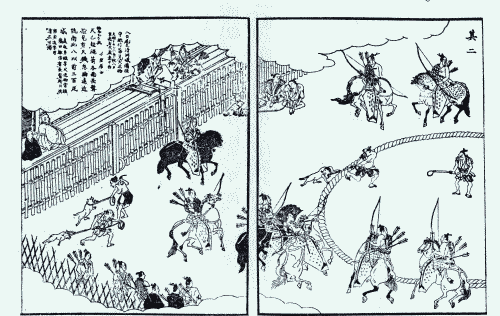Inuoumono
Inuoumono (犬追物) was a Japanese sport that involved mounted archers shooting at dogs. The dogs were released into a circular enclosure approximately 15m across, and mounted archers would fire upon them whilst riding around the perimeter.[1]

Originally intended as a military training exercise,[2] dog-shooting became popular as a sport among the Japanese nobility during the Kamakura and Muromachi periods (1185-1573).[3] During this time it was briefly banned during the rule of Emperor Go-Daigo (owing to his concern for the dogs); however, this ruling was overturned by the shōgun Ashikaga Takauji at the behest of his archery teacher Ogasawara Sadamune.[4] The influential Ogasawara family were particular adherents of inuoumono; Sadamune's archery treatise Inuoumono mikuanbumi regarded it as fundamental to a warrior's training, and his great-grandson Mochinaga devoted five books to the subject.[5]
The arrows used in dog-shooting were usually rendered non-fatal, by being either padded[6] or blunted.[7] This modification to the original sport was suggested by the Buddhist clergy, as a way of preventing injury to the dogs used.[8]
Inuoumono waned in popularity during the sixteenth century and has been largely extinct as a practice since then. It was eventually banned outright during the reign of Tokugawa Iemochi. Occasional revivals have taken place: there is a record of the shōgun Tokugawa Ieyoshi viewing dog-shooting in 1842, and the sport was performed for Ulysses S. Grant during an official visit to Japan in 1879 (Grant reportedly expressed distaste for the practice).[9] The last recorded instance of dog-shooting took place before the Meiji Emperor in 1881.[3]
References
- Louis Frédéric; Käthe Roth (2002). Japan Encyclopedia. Harvard University Press. p. 392. ISBN 978-0-674-01753-5. Retrieved 22 February 2013.
- Mari Womack (2003). Sport As Symbol: Images of the Athlete in Art, Literature and Song. McFarland. p. 131. ISBN 978-0-7864-1579-3. Retrieved 22 May 2012.
- Doris G. Bargen (2006). Suicidal Honor: General Nogi and the Writings of Mori Oḡai and Natsume Sos̄eki. University of Hawaii Press. p. 107. ISBN 978-0-8248-2998-8. Retrieved 22 May 2012.
- Jeffrey P. Mass (1 September 2002). The Origins of Japan's Medieval World: Courtiers, Clerics, Warriors, and Peasants in the Fourteenth Century. Stanford University Press. p. 232. ISBN 978-0-8047-4379-2. Retrieved 22 May 2012.
- G. Cameron Hurst. Armed Martial Arts of Japan. Yale University Press. pp. 120–121. ISBN 978-0-300-11674-8. Retrieved 27 June 2012.
- Yoko Woodson; Junʼichi Takeuchi; Thomas Cleary; Takeuchi Jun'ichi; Morihiro Hosokawa; Junko Abe; Asian Art Museum--Chong-Moon Lee Center for Asian Art and Culture; Eisei Bunko (5 May 2009). Lords of the samurai: the legacy of a daimyo family. Asian Art Museum--Chong-Moon Lee Center for Asian Art and Culture. p. 131. ISBN 978-0-939117-46-8. Retrieved 22 May 2012.
- Charles E. Grayson; Mary French; Michael J. O'Brien (1 November 2007). Traditional Archery from Six Continents: The Charles E. Grayson Collection. University of Missouri Press. pp. 38 (caption). ISBN 978-0-8262-1751-6. Retrieved 22 May 2012.
- Thomas Louis; Tommy Ito (5 August 2008). Samurai: The Code of the Warrior. Sterling Publishing Company, Inc. p. 61. ISBN 978-1-4027-6312-0. Retrieved 22 May 2012.
- Allen Guttmann; Lee Austin Thompson (2001). Japanese Sports: A History. University of Hawaii Press. p. 52. ISBN 978-0-8248-2464-8. Retrieved 22 May 2012.
